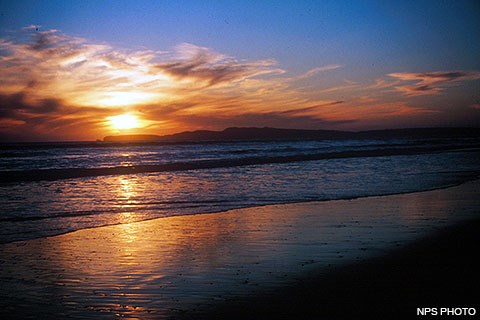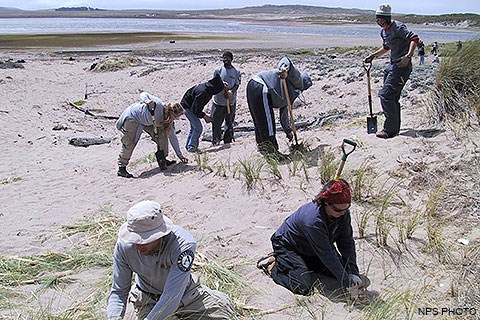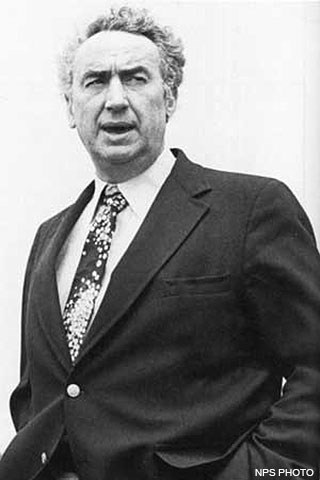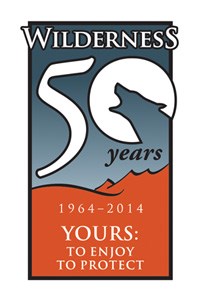
Point Reyes National Seashore is home to the Phillip Burton Wilderness Area, where visitors can explore over 30,000 acres of forested ridges, coastal grasslands, sand dunes, and rugged shoreline. Visitors can enjoy a quiet evening on a secluded beach watching the sun set over the Pacific Ocean, or experience the power of a winter storm or the spring winds generating massive waves on the Point Reyes Beach. Over 100 miles of trails wind their way through the Phillip Burton Wilderness, inviting visitors to leave the stress of today's mechanical/electronic world behind for an hour or a day. Wildlife also thrives throughout the park's Wilderness. Visitors may observe tule elk on Tomales Point, harbor seals, waterfowl, and shorebirds in the Estero de Limantour, and a multitude of marine invertebrates in tidepools. These are just a few of the many benefits of wilderness. All of this within a couple-hours travel time for over eight million San Francisco Bay area residents. The land that is now Point Reyes National Seashore and the Phillip Burton Wilderness are the traditional homelands of Coast Miwok, who had lived throughout what is now Marin County and southern Sonoma County since time immemorial. In the early 1800s, Franciscan missionaries introduced feral cattle to the area. Secularization of the missions following Mexican independence from Spain led to land grant subdivision and the expansion of cattle ranching on the peninsula. In the late 1800s, over 30 ranches were established across the peninsula, many of which still operate today outside of the Phillip Burton Wilderness. In 1962, Congress authorized the National Park Service to purchase the ranch lands in order to create Point Reyes National Seashore, and later passed legislation in 1976 to designate some of those lands as wilderness. Point Reyes National Seashore's Park Map (8,511 KB PDF) indicates which sections of the park are protected as the Phillip Burton Wilderness. As of 2024, the Philip Burton Wilderness encompassed 27,315 acres of designated wilderness and 5,415 acres of potential wilderness. (Acreage cited is based on "current" acreages informed by GIS mapping technology, which may differ from older sources.) 
Wilderness areas are public lands. This means wilderness belongs to everyone. Wilderness areas also provide intact habitat for wildlife, clean drinking water for cities, recreational opportunities for outdoor enthusiasts, sources of inspiration for artists, and much more. Wilderness areas also provide a place for reflection and introspection. What does wilderness means to you? Is it a place of inspiration? Adventure? Or maybe even a place you have not visited but still appreciate? We can all be stewards of these special places and ensure their protection well into the future. Visit Wilderness Volunteers' website to learn more about how you can be a wilderness steward. 
The year 2014 marked the 50th Anniversary of the Wilderness Act, making it the perfect time to have a wilderness experience. President Lyndon B. Johnson signed the Wilderness Act on September 3, 1964, to provide the highest level of protection for some of America's iconic, wild landscapes. The US Congress passed legislation (Public Law 94-544) in 1976 that created the Point Reyes Wilderness. The Congress passed Public Law 99-68 in 1985, which declared: In recognition of Congressman Phillip Burton's dedication to the protection of the Nation's outstanding natural, scenic, and cultural resources and his leadership in establishing units of the National Park System and preserving their integrity against threats to those resources and specifically his tireless efforts which led to the enactment of the California Wilderness Act of 1984, the designated wilderness area of Point Reyes National Seashore, California as established pursuant to law, shall henceforth be known as the "Phillip Burton Wilderness". Phillip Burton served in the US House of Representatives from 1964 until his death on April 10, 1983. Learn more about Congressman Phillip Burton: 1926-1983. 
In celebration of the Wilderness Act's 50th anniversary, visitors from around the world hiked wilderness trails, explored wilderness areas online, and further strengthened their connection to these special American places. National parks across the country recognized this important anniversary in ways as diverse as the landscapes they were honoring—wilderness walks, art exhibits, trail maintenance projects, guest speakers, etc. The public was invited to join your national parks to recognize the 50th anniversary of the Wilderness Act by participating in one of the many activities offered. Learn more about Wilderness Stewardship and Science in Park Science's Winter 2011–2012 issue. Learn More about the Phillip Burton WildernessMultimediaTranscript
Video Transcript: Point Reyes Wilderness: A Conversation with Park Rangers
[What is Wilderness to You?] Anela Ramos: When I think of wilderness, I imagine places undisturbed where you can just enjoy the silence and really see the plants and animals at their best. John Eleby: Wilderness for me is that place to escape to. I think it’s so necessary for us as people to go back to our roots of what we were and it’s just out being in the wild. Doug Hee: Wilderness is being in a place where you’re there on its own terms. It’s not expecting anything. It’s not expecting the environment to look after you, to take care of my needs. Wilderness is there, really for me, to take care of its needs. Kevin Haney: I grew up here in Marin and this is kind of my backyard essentially. Definitely spent a lot of time recreating out here in the wilderness. Hiking and going to the beach was definitely a large part of my childhood visiting our Seashore here. [How does your job relate to to Wilderness?] AR: As an interpretive ranger, I am here to educate visitors about wilderness. We tell visitors that they’re entering wilderness for one. JE: We enforce the laws that are designed to protect the wilderness. So you got the simple things from pets in closed areas, not being able to bring your dog into the wilderness area all the way up to damage to natural resources, unattended fires, and things like that. [How can visitors connect to and help protect Wilderness?] DH: It becomes a moral imperative that we take steps to protect it, which means that we’ll have to educate folks about how to do that themselves. It’s a collaborative effort, it’s a collective effort that we need to make in order to ensure that wilderness is protected into the future. JE: It’s really important as the visitation for Point Reyes National Seashore keeps rising that visitors familiarize themselves with the rules and reg’s (regulations) of the park and specifically those that pertain to wilderness. So familiarizing yourself with the “pack in-pack out” policy as well as how to treat fires. And there’s really good reason we have our fire rules here. KH: Protecting the wilderness is really easy to do and part of what many of us already do already. It’s following “Leave No Trace” principles when you’re in the backcountry and even if you’re in the frontcountry you can do that. As we put less pressure on the areas that we can use, that puts less pressure on the areas that we want to protect. JE: So for each warning that we give, each citation that we write, or each contact that we make, we’re just trying to educate the public towards that goal. AR: It’s not always something that gets across so, they’re [visitors] just like “oh I’m just going for a hike!” but hopefully while they’re out there exploring Point Reyes and being on the trails and really enjoying themselves out there, we hope that it instills a connection to them that they’ll want to preserve this place. [What is your favorite Wilderness area at Point Reyes?] JE: That’s kind of a tough one to answer because there’s so many good ones, but I guess if I had to pick, I guess the top favorite, Coast Trail, would have to be my answer. AR: It’s hard to choose! DH: You know, I’d have to say, I think Tomales Point is great, it’s wonderful. You really do get a sense that you’re out in the middle of nowhere. KH: The Laguna Trail would probably be my favorite part of the wilderness. AR: Every part of wilderness is special and unique in its own way and you want to experience all of it and you can’t just choose one. And it’d be difficult to say this wilderness is better than the other. They’re all equally worth visiting. [What is unique about the Wilderness at Point Reyes?] KH: Here at Point Reyes, the wilderness is really diverse. You know we have our bishop pine forest, we have our rugged coastlines, our coastal dunes, there’s just so much here that it’s hard to pick one really. DH: We’ve got the land mass of wilderness but we also have the marine area that makes it an incredibly wild feeling. AR: That’s the beauty of it is that, things that are wild can be far away, you might have to drive eight hours to go and see the Sierra, but there are places that are wild that are just in your backyard. And hopefully wilderness is going to be an idea that everyone has access to. That wild areas will be in urban places and you don’t get have to get very far, or you don’t have to go very far, to just be one with nature. [Why is Wilderness important?] JE: Wilderness is important because it reminds us of where we came from. I forget who said it, but wilderness, just you don’t have to even go to it, but knowing that it’s there, knowing that it’s out there, is of intrinsic value to the human soul. So just, for me being able to go to it, being able to go to a place, walk a trail or even walk off trail, you see no sign of human habitation. It’s a place where it feels WILD. It feels like, I might get eaten out here, and I don’t know how that works out in the human psyche, but that’s kind of a good feeling, to know that those places still exist. KH: At the end of my programs, I ask people what they think they could do to become wilderness defenders. Edward Abbey said that wilderness, the idea of wilderness doesn’t need any defense, it just needs more defenders. So that’s kind of my call to action at the end of the program. DH: There are places that have been set aside in this country, where we can be assured that things are left as they would be without us and just even knowing that is valuable.
Visit our keyboard shortcuts docs for details
Four park rangers share their thoughts about Wilderness. Videos from NPSWilderness:
Visit our keyboard shortcuts docs for details
The Wilderness Act of 1964 established the National Wilderness Preservation System, a national network of more than 800 federally-designated wilderness areas. These wilderness areas are managed by the National Park Service, Bureau of Land Management, US Fish and Wildlife Service, and US Forest Service.
Visit our keyboard shortcuts docs for details
Point Reyes National Seashore, located just an hour north of San Francisco, is home to the Phillip Burton Wilderness. This wilderness area protects more than 26,000 acres of important habitat and serves as a place of inspiration for people near and far.
Visit our keyboard shortcuts docs for details
See the natural rhythms of Point Reyes National Seashore's Phillip Burton Wilderness. Point Reyes is the windiest place on the Pacific Coast, one of the foggiest places in North America, and home to thirty-eight threatened or endangered species.
Visit our keyboard shortcuts docs for details
Join local photographers Kathleen Goodwin and Richard Blair on Kehoe Beach in the Phillip Burton Wilderness. Point Reyes National Seashore includes 80 miles of coastline, most of which is designated wilderness. |
Last updated: April 26, 2024
